Aston Martin Lagonda Global Holdings PLC is a British manufacturer of luxury sports cars and grand tourers. Its predecessor was founded in 1913 by Lionel Martin and Robert Bamford. Steered from 1947 by David Brown, it became associated with expensive grand touring cars in the 1950s and 1960s, and with the fictional character James Bond following his use of a DB5 model in the 1964 film Goldfinger. Their grand tourers and sports cars are regarded as a British cultural icon.
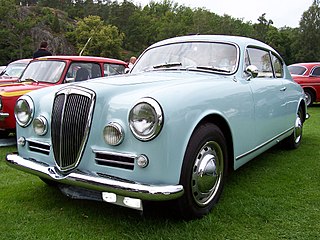
A grand tourer (GT) is a type of car that is designed for high speed and long-distance driving with performance and luxury. The most common format is a front-engine, rear-wheel-drive two-door coupé with either a two-seat or a 2+2 arrangement. Grand tourers are often the coupé derivative of luxury saloons or sedans. Some models, such as the Ferrari 250 GT, Jaguar E-Type, and Aston Martin DB5, are considered classic examples of gran turismo cars.

Ferrari America is a series of flagship grand touring Ferrari models primarily built for the North American market in the 1950s and 1960s. The America models were equipped with large V12 engines and often had custom bodywork done by famous coachbuilders in Italy. All America models used a live axle in the rear, were front-engined, and had worm and sector steering.

The Ferrari 250 is a series of sports cars and grand tourers built by Ferrari from 1952 to 1964. The company's most successful early line, the 250 series includes many variants designed for road use or sports car racing. 250 series cars are characterized by their use of a 3.0 L (2,953 cc) Colombo V12 engine designed by Gioacchino Colombo. The 250 series designation refers to this engine's cylinder displacement of approximately 250 cc. They were replaced by the 275 and 330 series cars.

Reginald Parnell was a racing driver and team manager from Derby, England. He participated in seven Formula One World Championship Grands Prix, achieving one podium, and scoring a total of nine championship points.

The Aston Martin DB2 is a grand tourer that was sold by Aston Martin from May 1950 until April 1953. The successor to the 2-Litre Sports model, it had a comparatively advanced dual overhead cam 2.6 L Lagonda straight-6 engine in place of the previous overhead valve engine straight-four engine. It was available as a closed, 2-seater coupé which Aston Martin called a sports saloon, and later also as a drophead coupé, which accounted for a quarter of the model's total sales. The closed version had some success in racing.

The Aston Martin DB2/4 is a grand tourer produced by Aston Martin from 1953 until 1957. It was available as a 2+2 hatchback saloon, drophead coupé (DHC) and 2-seat fixed-head coupé. A small number of Bertone bodied spiders were commissioned by private buyers.

The Aston Martin Virage is an automobile produced by British luxury automobile manufacturer Aston Martin as a replacement for its V8 models. Introduced at the Birmingham Motor Show in 1988, it was joined by the high-performance Vantage in 1993, after which the name of the base model was changed to V8 Coupe in 1996.

The Aston Martin Vantage is a series of hand-built sports cars from the British automotive manufacturer Aston Martin. Aston Martin has previously used the "Vantage" name on high-performance variants of their existing GT models, notably on the Virage-based car of the 1990s. The modern car, in contrast, is the leanest and most agile car in Aston's lineup. As such, it is intended as a more focused model to reach out to potential buyers of cars such as the Porsche 911 as well as the exotic sports and GT cars with which Aston Martins traditionally compete.

The Aston Martin DB3S is a sports racing car that was built by Aston Martin. Following the failure of the heavy and uncompetitive Aston Martin DB3 designed by Eberan Eberhorst; William Watson, employed as Eberhorst's assistant, presented an alternative design to John Wyer, Aston Martin's competitions manager, whose assistance was needed as Eberhorst could well oppose being up-staged. In total 31 cars were made, with 11 works cars and 20 cars being sold for customer use.
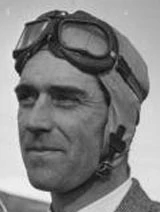
Peter Douglas Conyers Walker was an English racing driver. He was born in Huby, Yorkshire and died in Newtown, Worcestershire. He proved a strong driver in most disciplines, but was most adept in sports cars, winning the 1951 24 Hours of Le Mans race, and the Goodwood Nine-Hours in 1955. He effectively retired after a crash in 1956 left him with serious injuries.
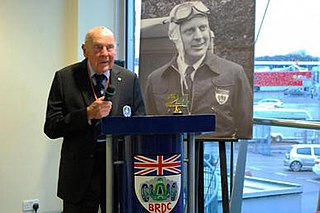
Eric David Thompson was a British racing driver, book dealer and insurance broker. He participated in sports car racing between 1949 and 1955 taking his greatest success by finishing third in the 1951 Les 24 Heures du Mans and took part in the 1952 RAC British Grand Prix.

The Lagonda Straight-6 is a famous automobile engine used by Aston Martin and Lagonda marques in the 1950s. Designed by Willie Watson under the supervision of Walter Owen Bentley of Bentley Motors Limited, it vaulted Aston Martin to fame as a maker of desirable sports and racing cars.

The Ferrari Monza is one of a series of cars built by Ferrari. In the early 1950s, Ferrari shifted from using the compact Gioacchino Colombo-designed V12 engine in its smallest class of sports racers to a line of four-cylinder engines designed by Aurelio Lampredi. Inspired by the success of the light and reliable 2.5 L 553 F1 car, the four-cylinder sports racers competed successfully through the late 1950s, culminating with the famed 500 Mondial and 750 Monza.
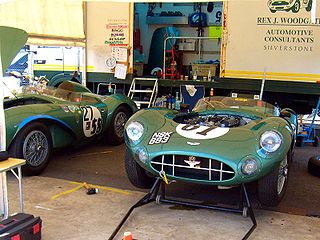
The Aston Martin DBR1 is a sports racing car built by Aston Martin starting in 1956, intended for the World Sportscar Championship as well as non-championship sportscar races at the time. It is most famous as the victor of the 1959 24 Hours of Le Mans, Aston Martin's only outright victory at the endurance classic. It is one of only three cars in the 1950s to win both the World Sports Car Championship and Le Mans 24 Hours in the same year. In addition the six World Sports Car Championship victories was a record for any car in the 1950s and remained a record in the championship until surpassed by the Ferrari 250TR. The three consecutive triumphs in 1959 at the Nürburgring, Le Mans and the Tourist Trophy equalled the record set by the Ferrari 250TR with its three consecutive victories at the start of the 1958 season.

The Aston Martin DBR2 was a sports racing car built in 1957 as a sibling to the Aston Martin DBR1, yet competing in a larger engine capacity group.

The Aston MartinAtom is a prototype automobile built by Aston Martin (AM). Construction of the car began in 1939 and was completed in 1940. The Atom is one of the first fully functional concept cars ever built. Aston Martin explored several new technologies with the Atom, and its chassis design was the basis for the platform used by AM's post-war models well into the late 1950s.
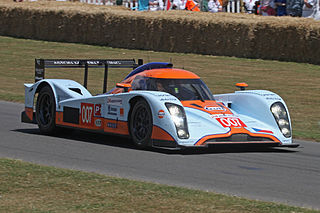
The Lola-Aston Martin B09/60, also known as the Aston Martin DBR1-2, is a Le Mans Prototype sports car built by Lola Cars International and co-developed with Prodrive for use by Aston Martin Racing. It is the first prototype to bear the Aston Martin name since the AMR1 in 1989. Aston Martin's internal name for the car, DBR1-2, refers to the specific DBR1 chassis which won six races in 1959 en route to clinching the World Sportscar Championship as well as that year's 24 Hours of Le Mans.
Edward John 'Ted' Cutting was a British automotive engineer. He designed the body, engine, chassis, suspension and fully engineered the Aston Martin DBR1, winner of the 1959 24 Hours of Le Mans.
Pat Griffith was an English racing driver, who raced for the works Aston Martin team during the early 1950s, winning the 1953 RAC Tourist Trophy.




















